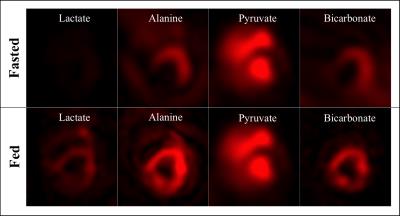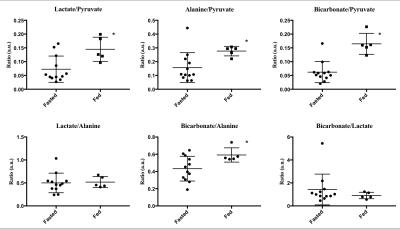3607
Hyperpolarized [1-13C]Pyruvate MRI identifies metabolic differences pertaining to the fasted and fed state in porcine cardiac metabolism1Department of Cardiology - Research, Aarhus University Hospital, Aarhus N, Denmark, 2MR Research Centre, Aarhus University, Aarhus N, Denmark
Synopsis
Standardized large animal models for cardiac hyperpolarized MR metabolic studies are becoming increasingly important as translation into human trials progresses. We employed a porcine (n=17) model of fasting/feeding to study these two states and to examine normal feeding as a standardized model for increasing hyperpolarized [1-13C]Pyruvate signal in the heart. All metabolic ratios were higher in fed animals with no additional variance. This indicates the role of pyruvate uptake to be more important in pigs than in rodents, underlining the need for large animals in metabolic research, and also suggests feeding to be a feasible, standardized model for increasing signal.
Purpose
Hyperpolarized MR with [1-13C]Pyruvate is increasingly employed in the study of cardiac metabolism1,2. Small animal models are still used most frequently, but large animal models3-9 are increasingly important as the technology is translated into humans10,11. Methodological challenges, coupled with the complex and transient nature of cardiac metabolism, have entailed that the metabolic derangements that occur in disease are still not understood3,12-14. Although hyperpolarized MR promises to overcome aforementioned methodological challenges, the changeable nature of cardiac metabolism must be kept in mind when designing studies utilizing this technique. It is necessary to standardize the subjects’ metabolic state and several methods have been used in an effort to achieve this; fasting, oral glucose load3,11 and glucose-insulin-potassium (GIK)-infusion15, among others. Fasting causes low carbohydrate dependence and concurrent low signal/poor image quality in [1-13C]Pyruvate studies, and glucose load, or infusion with GIK, does not seem entirely physiological. We employed a large animal model of fasting/normal feeding to study the differences between these two states, and to examine the feasibility of normal feeding as a model for increasing signal strength in hyperpolarized MR studies.Methods
Seventeen Danish Landrace pigs weighing 30 kg were included in this study. Twelve were subjected to an overnight fast and five were fed on the morning of the experiments. Both groups were anaesthetized with propofol/fentanyl, intubated and ventilated. Each pig was scanned with hyperpolarized [1-13C]Pyruvate cardiac MR on a clinical 3T GE HDx MR scanner (GE Healthcare). The scan protocol was: initial proton images to position the slice, a Bloch-Siegert sequence for calibration and a spiral CSI sequence for data-acquisition. 13C-data was acquired with a 13C Helmholtz loop coil of 20cm in diameter (PulseTeq Limited). All scans were ECG-triggered in the diastolic phase and performed during breath-hold. Vital parameters and blood samples were obtained immediately before the [1-13C]Pyruvate-scan. Regions of Interest (ROIs) were drawn to outline the myocardium and exclude signal from the ventricular lumen from analysis. Results were calculated as summed metabolite-signal from the entire scan sequence, i.e. lactate, alanine, pyruvate and bicarbonate, divided by summed normalizing signal, i.e. pyruvate and alanine. Statistics performed were t-test, F-test for variance and linear regression.Results
Results are presented as mean±SD. Blood glucose concentration and Mean Arterial Pressure (MAP) was significantly higher in the Fed group, compared to the Fasted group. No other physiological parameters varied significantly between groups, see Figure 1. Image quality was consistently good for all metabolites in both groups by visual inspection; however, a much better delineation of the myocardium was noted in the Fed group, see Figure 2. Lactate/pyruvate-ratio was 99% higher in the Fed group, compared with the Fasted (p=0.0163) group. Alanine/pyruvate-ratio was 76% higher (p=0.0039), bicarbonate-pyruvate-ratio 166% (p=0.0011) higher, and bicarbonate/alanine-ratio was 37% higher in the Fed group (p=0.0136). Neither lactate/alanine (p=0.8225) nor bicarbonate/lactate-ratios (p=0.2179) differed significantly, see Figures 3 and 4. Variance was lower in the Fed group for the alanine/pyruvate- and bicarbonate/lactate-ratios, (p-values=0.0411 and 0.0084). No other differences in variance between groups were found, see Figure 4. No significant correlations between blood sugars and metabolite signal could be detected.Discussion
The main finding of this study was a concomitant increase in signal from 13C-labelled lactate, alanine, and bicarbonate production in the myocardium of fed animals compared to fasted. No difference in the balance between the lactate and bicarbonate pool was found. The elevated 13C-lactate and -bicarbonate signals likely denote increased activity in glycolysis and carbohydrate oxidation, due to suppression of free-fatty acid (FFA) beta-oxidation in response to feeding and increased glucose availability, as expected. However, the comprehensive increase in 13C metabolism, incl. increased formation of alanine, upon feeding also suggests that [1-13C]Pyruvate uptake may have been limited in fasted hearts. Therefore, the role of pyruvate uptake is possibly much more pronounced in large animals than in rodents16,17.Conclusion
In this study, we show fed pigs to have a higher myocardial conversion of pyruvate to lactate, alanine and bicarbonate than fasted pigs. This result signified higher activities of the aerobic and anaerobic pathways, owing to up-regulation of glucose metabolism, but also likely owing to increased pyruvate uptake. These findings are dissimilar to results obtained from rodent studies and underline the necessity for large animal studies in metabolic research, as the metabolism of these animals are different from that of small animals, and may resemble human physiology more closely. We further demonstrate the feasibility of using normal feeding as a model for increasing myocardial metabolite signal as an alternative to fasting and giving oral glucose. This model increases all metabolite ratios with no additional variance.Acknowledgements
The authors wish to thank Henrik Vestergaard Nielsen for his notable assistance with pyruvate sample-preparation and SpinLab-operation and Casper Carlsen Elkjær for his assistance with blood sample analysis.
This study was funded by The Danish Heart Foundation, Aarhus University, Karen Elise Jensen’s Foundation, Director Kurt Bønnelycke and Wife’s Foundation and the Danish Diabetes Academy supported by The Novo Nordisk Foundation.
References
1. Ardenkjaer-Larsen JH, Fridlund B, Gram A, Hansson G, Hansson L, Lerche MH, Servin R, Thaning M, Golman K. Increase in signal-to-noise ratio of > 10,000 times in liquid-state NMR. Proceedings of the National Academy of Sciences of the United States of America. 2003;100(18):10158–10163.
2. Tyler DJ, Neubauer S. Science to Practice: Hyperpolarized Metabolic MR Imaging--The Light at the End of the Tunnel for Clinical (13)C MR Spectroscopy? Radiology. 2016;278(3):639–641.
3. Schroeder MA, Lau AZ, Chen AP, Gu Y-P, Nagendran J, Barry J, Hu X, Dyck JRB, Tyler DJ, Clarke K, Connelly KA, Wright GA, Cunningham CH. Hyperpolarized (13)C magnetic resonance reveals early- and late-onset changes to in vivo pyruvate metabolism in the failing heart. European Journal of Heart Failure. 2013;15(2):130–140.
4. Wigh Lipsø K, Hansen ESS, Tougaard RS, Laustsen C, Ardenkjaer-Larsen JH. Renal MR angiography and perfusion in the pig using hyperpolarized water. Magnetic Resonance in Medicine. 2016.
5. Flori A, Liserani M, Frijia F, Giovannetti G, Lionetti V, Casieri V, Positano V, Aquaro GD, Recchia FA, Santarelli MF, Landini L, Ardenkjaer-Larsen JH, Menichetti L. Real-time cardiac metabolism assessed with hyperpolarized [1-(13) C]acetate in a large-animal model. Contrast Media & Molecular Imaging. 2015;10(3):194–202.
6. Lau AZ, Chen AP, Barry J, Graham JJ, Dominguez-Viqueira W, Ghugre NR, Wright GA, Cunningham CH. Reproducibility study for free-breathing measurements of pyruvate metabolism using hyperpolarized (13) C in the heart. Magnetic Resonance in Medicine. 2013;69(4):1063–1071.
7. Menichetti L, Frijia F, Flori A, Wiesinger F, Lionetti V, Giovannetti G, Aquaro GD, Recchia FA, Ardenkjaer-Larsen JH, Santarelli MF, Lombardi M. Assessment of real-time myocardial uptake and enzymatic conversion of hyperpolarized [1-¹³C]pyruvate in pigs using slice selective magnetic resonance spectroscopy. Contrast Media & Molecular Imaging. 2012;7(1):85–94.
8. Hansen ESS, Stewart NJ, Wild JM, Stødkilde-Jørgensen H, Laustsen C. Hyperpolarized (13) C,(15) N2 -Urea MRI for assessment of the urea gradient in the porcine kidney. Magnetic Resonance in Medicine. 2016.
9. Laustsen C, Hansen ESS, Kjaergaard U, Bertelsen LB, Ringgaard S, Stødkilde-Jørgensen H. Acute porcine renal metabolic effect of endogastric soft drink administration assessed with hyperpolarized [1-(13)C]pyruvate. Magnetic Resonance in Medicine. 2015;74(2):558–563.
10. Nelson SJ, Kurhanewicz J, Vigneron DB, Larson PEZ, Harzstark AL, Ferrone M, van Criekinge M, Chang JW, Bok R, Park I, Reed G, Carvajal L, Small EJ, Munster P, Weinberg VK, et al. Metabolic Imaging of Patients with Prostate Cancer Using Hyperpolarized [1-13C]Pyruvate. Science Translational Medicine. 2013;5(198):198ra108–198ra108.
11. Cunningham CH, Lau JY, Chen AP, Geraghty BJ, Perks WJ, Roifman I, Wright GA, Connelly KA. Hyperpolarized 13C Metabolic MRI of the Human Heart: Initial Experience. Circulation Research. 2016:CIRCRESAHA.116.309769.
12. Neubauer S. The failing heart--an engine out of fuel. The New England journal of medicine. 2007;356(11):1140–1151.
13. Stanley WC, Recchia FA, Lopaschuk GD. Myocardial substrate metabolism in the normal and failing heart. Physiological Reviews. 2005;85(3):1093–1129.
14. Lopaschuk GD, Ussher JR, Folmes CDL, Jaswal JS, Stanley WC. Myocardial Fatty Acid Metabolism in Health and Disease. Physiological Reviews. 2010;90(1):207–258.
15. Lauritzen MH, Laustsen C, Butt SA, Magnusson P, Søgaard LV, Ardenkjaer-Larsen JH, Åkeson P. Enhancing the [13C]bicarbonate signal in cardiac hyperpolarized [1-13C]pyruvate MRS studies by infusion of glucose, insulin and potassium. NMR in Biomedicine. 2013;26(11):1496–1500.
16. Josan S, Park JM, Hurd RE, Yen Y-F, Pfefferbaum A, Spielman DM, Mayer D. In vivoinvestigation of cardiac metabolism in the rat using MRS of hyperpolarized [1- 13C] and [2- 13C]pyruvate. NMR in Biomedicine. 2013;26(12):1680–1687.
17. Dodd MS, Ball V, Bray R, Ashrafian H, Watkins H, Clarke K, Tyler DJ. In vivo mouse cardiac hyperpolarized magnetic resonance spectroscopy. Journal of cardiovascular magnetic resonance : official journal of the Society for Cardiovascular Magnetic Resonance. 2013;15(1):19.
Figures

Table showing various parameters and the p-value for difference in means between the two groups.
BP=Blood pressure, MAP=Mean arterial pressure, BPM=Beats per minute, Timing=time from intubation to scan in hours, SD=Standard deviation. * denotes statistical significance.


